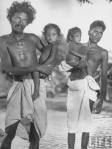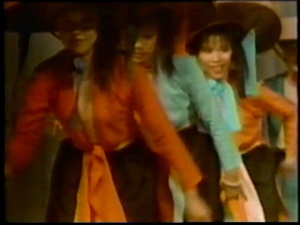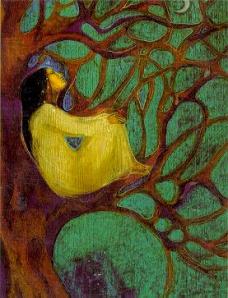Postcolonial Ecofeminism (Robert J. C. Young)
October 12, 2009 1 Comment
 You would not come to this class to read and learn about what you would normally get from standard media. So, the title of Monday’s discussion should not be a complete surprise. Its newness may require that you would read and meditate about these issues more carefully than you would with more familiar topics. These types of topics, nevertheless, would surely help you appreciate the human experience on the other side of nationalism.
You would not come to this class to read and learn about what you would normally get from standard media. So, the title of Monday’s discussion should not be a complete surprise. Its newness may require that you would read and meditate about these issues more carefully than you would with more familiar topics. These types of topics, nevertheless, would surely help you appreciate the human experience on the other side of nationalism.
 You already know that in this context postcoloniality means the people’s ambivalent experience and subordinate position even after independence from a colonial power. In other words, it is that state in which a former colony has nominal sovereignty because the former master (or new foreign ones) has not left entirely or has taken on new forms of domination. The struggle for freedom, thus, continues, not so much by pushing the foreign away, but in redefining the social structures that continues to promote inequality and subordination, which colonialism donated to the new nation (“inherited from colonialism”).
You already know that in this context postcoloniality means the people’s ambivalent experience and subordinate position even after independence from a colonial power. In other words, it is that state in which a former colony has nominal sovereignty because the former master (or new foreign ones) has not left entirely or has taken on new forms of domination. The struggle for freedom, thus, continues, not so much by pushing the foreign away, but in redefining the social structures that continues to promote inequality and subordination, which colonialism donated to the new nation (“inherited from colonialism”).
But what do ecology and feminism have to do with postcoloniality?
 Robert J. C. Young’s challenge in chapter 5 is simply asking us to appreciate the perspective of the women who struggled against colonial and later postcolonial domination in India and other parts of Asia and Africa. Their experience is not totally transferable to other postcolonial female experiences because each group had faced different set of trials and had had different types of needs. Rather, it is the overarching theme of resisting a modern patriarchal nationalism that puts them together in the same crowd.
Robert J. C. Young’s challenge in chapter 5 is simply asking us to appreciate the perspective of the women who struggled against colonial and later postcolonial domination in India and other parts of Asia and Africa. Their experience is not totally transferable to other postcolonial female experiences because each group had faced different set of trials and had had different types of needs. Rather, it is the overarching theme of resisting a modern patriarchal nationalism that puts them together in the same crowd.
 The section titled “Gender Politics in India” illustrates how notions about traditional roles for women are hard to reject. Even Mohandas Karamchand Gandhi, the great reformer who appropriated ‘feminized’ modes of struggle, came at times to reinforce, instead of rejecting, conventional Hindu and puritanical Victorian concepts of women and femininity. Young vindicated Gandhi, though, by showing that he genuinely realized that women’s politics was more radical than most nationalism. It argued for equitable relations between men and women, sustainable connections to the land, and a life-style and medicine that encourage collective health. These are the contributions of postcolonial women and their politics.
The section titled “Gender Politics in India” illustrates how notions about traditional roles for women are hard to reject. Even Mohandas Karamchand Gandhi, the great reformer who appropriated ‘feminized’ modes of struggle, came at times to reinforce, instead of rejecting, conventional Hindu and puritanical Victorian concepts of women and femininity. Young vindicated Gandhi, though, by showing that he genuinely realized that women’s politics was more radical than most nationalism. It argued for equitable relations between men and women, sustainable connections to the land, and a life-style and medicine that encourage collective health. These are the contributions of postcolonial women and their politics.
 In “Gender and Modernity” Young threw us several ideas about modernity that could easily mystify us. On the one hand, he wrote that technology and a politics of egalitarianism defines modernity. On the other, he asserted that (mythical) cultural nationalists and their obsession for a fabled past, where women stayed at home and were submissive, is all part of modernity. But his more interesting contribution, by far, was that there are several types of modernities, that there are different types of Third World modern experiences, and that even the West represent a diversity of modernities (think about how different is New Zeeland from the U.S.). The best explanation of modernity, however, is Young’s, and it appears in this section: the interaction of the West with the Rest.
In “Gender and Modernity” Young threw us several ideas about modernity that could easily mystify us. On the one hand, he wrote that technology and a politics of egalitarianism defines modernity. On the other, he asserted that (mythical) cultural nationalists and their obsession for a fabled past, where women stayed at home and were submissive, is all part of modernity. But his more interesting contribution, by far, was that there are several types of modernities, that there are different types of Third World modern experiences, and that even the West represent a diversity of modernities (think about how different is New Zeeland from the U.S.). The best explanation of modernity, however, is Young’s, and it appears in this section: the interaction of the West with the Rest.

Kongo Astronauts presents Postcolonial Dilemna Track #03 (Unended) – A psychotronic Film from DR Congo (2014) – Curated by SPARCK in collaboration with Kongo Astronauts for FUSE 37-2/Speculation.
Women’s struggle for equality and sustainability is the epitome of the postcolonial predicament according to the section “Women’s Movement after Independence.” While nationalist movements sought desperately to present a unified face during the conflicts against the direct colonial rule, after independence, the same nationalists (i.e., Religious nationalism) who preached equality and freedom tried relegating women to submission. Since the role of women actually degenerated with the “nation,” postcolonial feminism had been at the forefront of a “politics of egalitarianism that supports diversity rather than the cultural uniformity demanded for nationalism.” (99)

The performance “WOMAN and NATURE” was created during the Venice Biennale 2013.
The project describes the relationship between feminism and ecology, the mystical connection between woman and nature also called ECO FEMINISM. Woman and nature have a shared history of oppression by a patriarchal western society. Both are used and abused and cloth to extinction in a male system.
The section “Feminism and ecology” shows how “macho” nationalism continued with the same colonial politics of exploitation. It reinforced the same old social hierarchy; it exploited workers, women and the environment. Like the colonial government, the new nations colonized forests and minds in responses to market-oriented and scientific notions of the time. This brought deforestation and desertification to local economies and otherwise clean ecosystems.
All of this colonization was for the short-term commercial values of the marketplace, “trying to control nature just as patriarchy tries to control women.” (102) Women, however, because of their experience as cultivators and family enablers possessed repositories of knowledges about balances in nature and the effects of ecological disruptions. It is no wonder, then, that it were women activists who began the Chipko (tree huggers) movement and developed a philosophy of politics that resisted centralization, corruption and exploitation. Instead, they promoted justice, self-sufficiency, and empowerment of local knowledges.
In the section “What makes postcolonial feminism ‘postcolonial’?,” Young asked if postcolonial feminism amounted to a separate strand within postcolonial thought. His answer was simply no. In this section, Young addressed the malleability of postcolonial theory by explaining how feminism is at its core, and thus inseparable. It is also applicable to a wide variety of politics, and even though they might not include obvious gender perspectives, they all work from the same paradigm: the pursuit of collective justice and equality. These struggles may be waged inside the nation or in exile, as the examples of Radia Nasraoui and Gisèle Halimi shows.
 In the last section, “The untouchables: caste,” Young readily admitted that the postcolonial struggle is not limited to the legacy of the colonies. There are older vices that plagued modern society. In the Indian example, we see the caste system, which is much older than the British colonial government. The plight of the Dalits is its most explicit case injustice. “A quarter of the Indian population is made of such Dalits.” And they do most of the menial jobs and live segregated from the rest, with little access to anything we normally see as good from modernity.
In the last section, “The untouchables: caste,” Young readily admitted that the postcolonial struggle is not limited to the legacy of the colonies. There are older vices that plagued modern society. In the Indian example, we see the caste system, which is much older than the British colonial government. The plight of the Dalits is its most explicit case injustice. “A quarter of the Indian population is made of such Dalits.” And they do most of the menial jobs and live segregated from the rest, with little access to anything we normally see as good from modernity.
In class, I want you to think seriously about the meaning of feminism and its opposite, namely, patriarchalism. How women’s social position as historically close to the land and responsible for sustaining families shaped their politics differently to that of men.
You should also ponder over the dark side of macho-nationalism, its insistence on cultural uniformity. Most importantly, I expect you to deliberate on the reasons and causes of nationalisms continuing with the same unfair hierarchies imposed by colonial rules, and with the exploitations inaugurated by the colonial masters.
How do you fit Young in Benedict Anderson’s frame of thought? What parts correspond, even if slightly, and what elements are diametrically apart?






